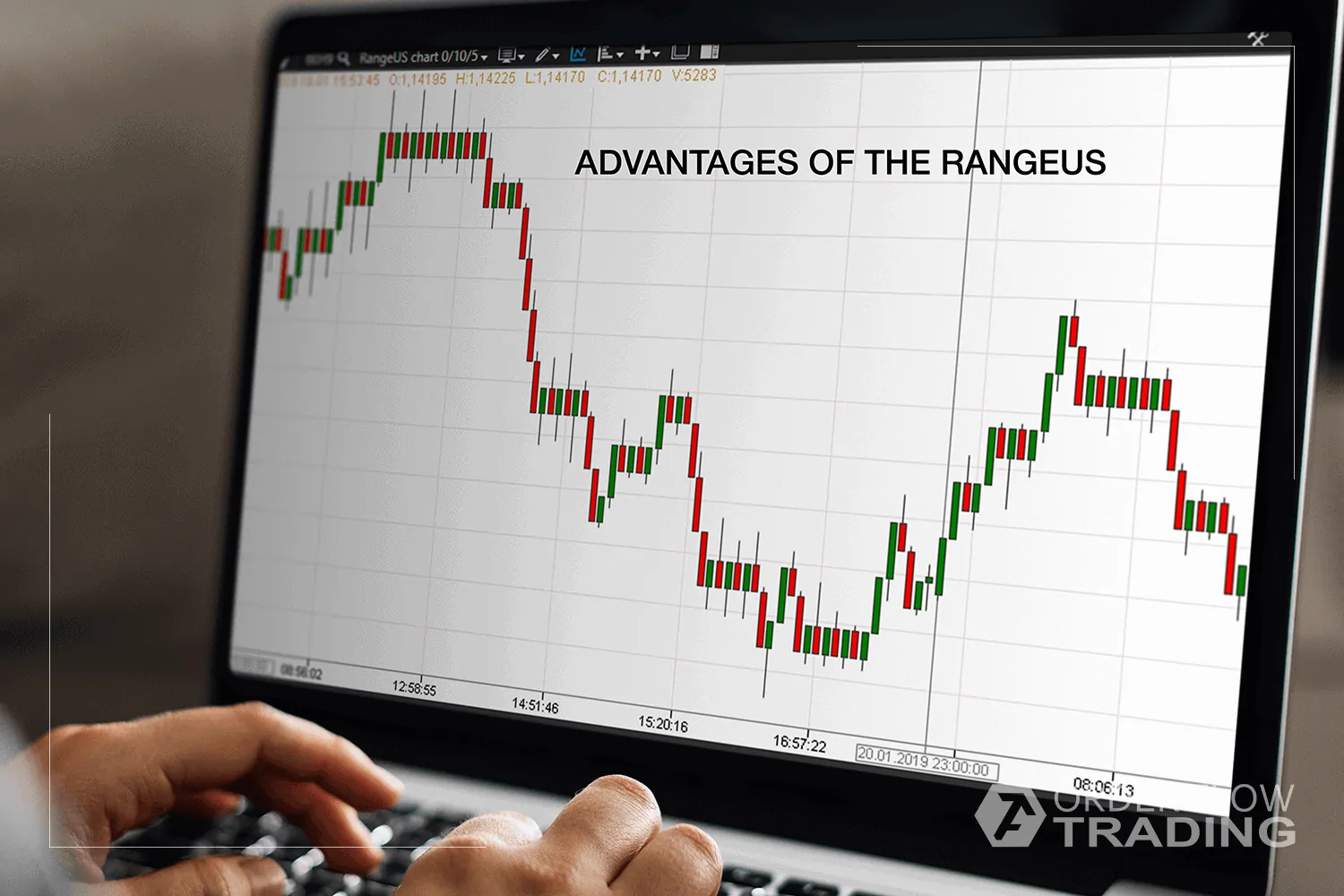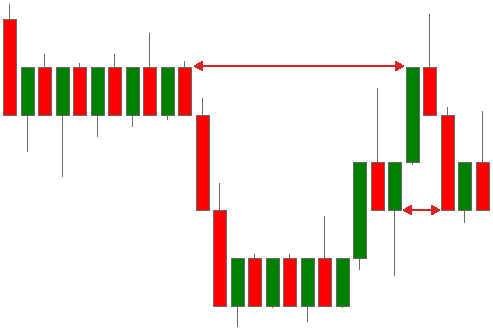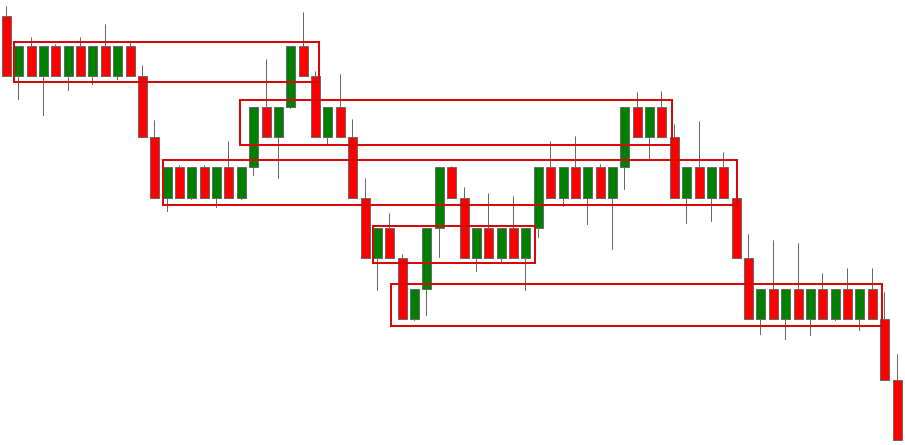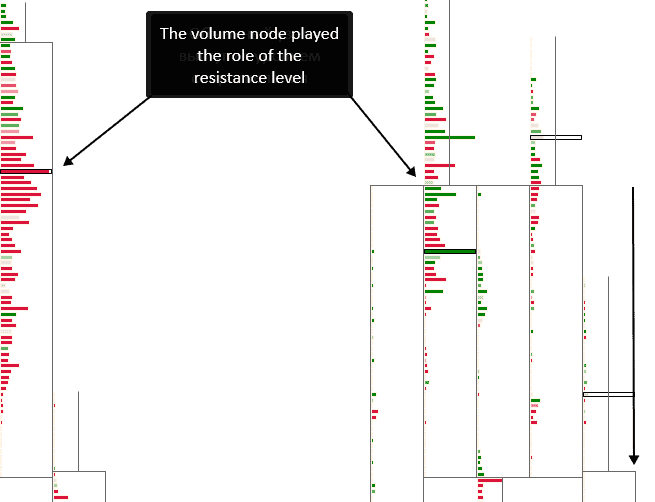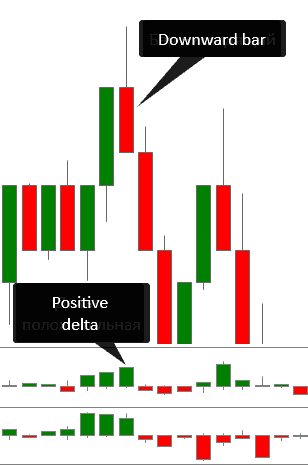How to find trades on the RangeUS
Ability to use various instruments for the market analysis is an important prerequisite for a success in the financial markets. In this article we will consider specific features of use of the RangeUS chart – a unique instrument of the ATAS platform.
Master the RangeUS. It will help you to identify the areas of accumulation of major participants and find the support and resistance levels more accurately.
In this article:
- what the RangeUS is;
- comparing the RangeUS chart and Japanese candles;
- the principle of building the RangeUS candles;
- advantages of the RangeUS chart and how they can be used;
- combining the RangeUS chart with the Delta and other indicators of the volume and technical analysis;
- selecting parameters for the RangeUS chart.
What the RangeUS chart is
RangeUS is a special chart, which filters out market noise and the candle (the “bar” term is also acceptable) building is carried out on the basis of a distance covered by the price. Such a chart depends neither on time nor on volume.
Example of the RangeUS chart on a 6E futures:
Visually, a RangeUS chart looks like classical candles. However, there are specific features, which we will discuss further.
Comparing the RangeUS chart with classical Japanese candles
Unlike a classical chart of Japanese candles, the RangeUS forms smooth boundaries in such a way, so that the previous highs and lows of the candles coincide with the next ones.
Compare two charts for the 6E instrument:
- RangeUS – to the left;
- Classical 5 min – to the right.
Note that 10 reversal candles appear in the left chart after the first trend candle and the price behavior resembles reciprocating motion. In other words, the price goes to and fro. Such reciprocating motions is a frequent case in the market and their availability points to a price stoppage in a range for identifying a further direction.
The same area in the right chart looks like a correction upward movement. It means that the same areas in the charts of different types can distort analysis and market perception by an analyst.
Support and resistance levels
When using the RangeUS chart, the support and resistance levels become more explicit.
Look at the chart below. It is a SiH9 futures contract from the Moscow Exchange. Blocks of reversal bars form levels, while testing which the price behavior becomes more predictable.
In case the price stays in a range for a long time, it is a sign of:
- a strong interest in holding the level and high intensity of both buyers and sellers (the struggle of supply and demand);
- or an absence of the pressure of the parties on the price (a flat, the price goes to nowhere).
However, as everybody knows, there is only one winner in the market. In the picture above, the predominance is obviously on the seller’s side. The repeated testing of such levels can become a signal for entering a rebound or breakout, depending on the price/volume behavior when entering the test area.
The principle of building the RangeUS candles
The RangeUS chart consists of two candle types:
- Trend;
- Reversal.
Three parameters are used when building them:
- Tick Trend – is a distance, achieving which a trend candle will be formed and closed. The distance is measured either up or down;
- Tick Reversal – is a distance, achieving which a reversal candle will be formed and closed. A mandatory condition for closing is a back (opposite) price movement in relation to a previous candle;
- Open Offset – is a shift from the session beginning, from which the first candle starts. Using this parameter affects the whole chart, since it shifts the rigid boundaries.
Let us analyze the RangeUS building on examples.
The picture below presents an example of building the RangeUS with the following parameters: Tick Trend – 10 and Tick Reversal – 5 for a 6E futures.
A trend candle of 10 price points size is located between the 1 and 2 marks. It was opened in point 1 and closed in point 2. Short candles with shadows are Tick Reversal, that is reversal candles.
The RangeUS charts (as well as in classical Japanese candlestick charts) can have candles with shadows, but they are always directed against the candles themselves. In other words, a downward red candle can have a shadow on top only, while an upward green in the bottom – no other way. This rule is pertinent only for already formed candles. If a candle is not closed, shadows can be anywhere.
There is a reversal candle of the 5 tick size between the 1 and 2 marks in the next picture. It was opened in point 2 and closed in point 1, but the price moved to point 3, which affected the long shadow formation.
A reversal candle was formed as an upward one. It means the the price passed 5 ticks in the opposite from the previous trend candle closing direction. Despite the fact that the candle, considered in this example, has a long shadow in the bottom, the price did not get across the limit of 10 ticks and came back upward. Reversal candles are formed in accordance with this principle.
If a trend candle is already formed and the price continues to move for 10 ticks in the same direction, then the following trend candle is formed (as in the picture).
Under certain settings, which are individual for various instruments, the RangeUS chart will hide the unnecessary market noise and will show important support and resistance levels.
The time, during which each candle is formed, will have different values. Some candles can be formed during a long period of time. As a rule, it is due to the fact that the price is traded in a narrow range during a long period of time. This could be connected with absence of pressure or, vice versa, due to a strong interest in holding the level.
How to use advantages of the RangeUS chart
Let us consider advantages, which we get from using the RangeUS chart, and also methods of their practical application:
Method 1. Formation of the RangeUS is not bound to time, which means that it becomes much easier to notice major accumulations. A major player often hides his plans and forms his position gradually, holding the price within certain boundaries, as if spreading his volume over time. Such a volume will be shown as one cluster in the RangeUS chart. A combination of the RangeUS chart and the cluster mode of display will show major volume levels in one bunch.
Example. The picture below shows the cluster mode of display of volumes for the RangeUS chart. A major volume of a seller is formed in the first downward candle. Further, when testing this area, the price faced resistance and turned in the opposite direction after a short trading:
Method 2. When using additional indicators for volume analysis, such as Volume, Delta and Open Interest, important levels will manifest themselves in areas where:
- there is an increased volume;
- the Delta value is bigger than average;
- there is a bigger open interest.
We will show an example of use of the Open Interest in the SiH9 market further in this article.
Method 3. The RangeUS chart is efficient for the search for reversal points. Use a combination of the RangeUS chart and Delta Indicator for finding a reversal.
The picture shows such a situation. At this moment we see an active major buyer in the Delta Indicator, but the candle is directed in the direction opposite to buys. This tells us about the change of priorities and decline of the buyer’s strength:
We considered only a few advantages of using the RangeUS chart. In fact, there are many other advantages. And if you are sharp sighted, you will find other possibilities for profitable trading.
Try it right now. Download ATAS and build the RangeUS chart in your market.
Combining the RangeUS chart with other indicators
Below is a chart on the SiH9 instrument from the Moscow Exchange. In this example we consider methods of search for a major player who will affect the futures price. The RangeUS chart has the following parameters: Trend – 75, Reversal – 50 with added Open Interest and Delta indicators and the considered period is January 22-25, 2019.
Major market participants became active in the area marked 1. As you can see, the price was in a narrow range.
The Delta in the A bar has a strong negative value of -14,730 contracts, which tells us that there is an active seller. The Open Interest increased by 53,600. Taking into account that the Open Interest value changes on oddly even values only, we can assume that practically the whole volume of the seller is directed to opening a short position. At the same time, the buyer, who also opened long positions, preferred limit orders rather than market ones, since we remember that the Delta has a strong negative value with the general traded volume of 132,000 contracts, which is significantly above average.
Let us consider the next B bar, since the gaining of a major position continued in it. The Delta of this bar was +36,000 contracts, which tells us about a beginning of the buyer’s activity. The Open Interest increased by 66,000 and the general volume was 266,000 contracts. Taking into account that 66,000/2=33,000, we have a situation, which is opposite to the previous one. Now the buyer acts proactively, gaining his position against the limit orders of the seller.
As you can see from the RangeUS chart, noone from the participants pushed the price. It continued to stay within the set boundaries for some time. Perhaps, it is connected with the fact that a more powerful player checked availability of the opposite volume.
We have two aggressive parties in the considered area, who stood against each other, that is why it is expedient to open your positions towards the winner.
A stronger party manifested itself by pushing the price down from the range. From which we make a conclusion that in this case namely the seller controls the market. When the situation became clearer, we already do not have grounds to make a decision on the basis of the following circumstances:
- the major player gained a short position, which means that we should expect a long-term trend movement;
- we know about a strong resistance level, while testing which it is expedient to open your position and post a short stop loss.
Testing of the major player level started soon and holding of this level only confirmed our expectations.
During the next trading session the price lost about 500 points and the major player continued to gain the short position, which we can see in the area 2. This area continued to play the role of the resistance level, which is shown by testing of the level by the price in the area 3.
This example clearly shows that additional use of the Delta and Open Interest indicators allows detecting important areas in the RangeUS chart.
Selection of parameters for the RangeUS chart.
We considered only a couple of parameters of setting and using the RangeUS chart. However, taking into account a variety of instruments and different characters of their behavior, the set parameters of the RangeUS will always be different. In order to understand what settings are optimal for each instrument, you can identify a set of parameters for yourself, which would become a basis for calculations.
For example, each instrument has a different Average True Range (ATR) or volatility (the price amplitude from low to high). The ATR indicator will help to calculate this parameter in the ATAS platform.
In the example below, the price ATR for the chart H1 of the SiH9 instrument of the Moscow Exchange is 154 points for 10 bars of 1 hour duration.
Thus, you can identify volatility (V) for every instrument and put this value in the basis of calculation of the Tick Trend and Tick Reversal values for the RangeUS chart. Experiment with the selected instruments and the following values could become the optimum ones: Tick Trend-V/2 and Tick Reversal=(Tick Trend/100)*75.
Summary
So, in this article we got acquainted with a non-traditional RangeUS chart, which allows eliminating the unnecessary market noise and concentrating on the major market participants accumulation areas. We also learnt how and with what instruments you can combine such a chart for analyzing a real-life situation.
Your personal monitoring and studying of such combinations will give you additional tips about emerging opportunities for trading in a harmony with the market.
Did you find the Range charts interesting? Check one more article about the analysis of Range charts.

